 Home >
Guides >
Building Battlefields | Basic Game | Master Game | Glossary
Home >
Guides >
Building Battlefields | Basic Game | Master Game | Glossary
Compiled Basic Game Guide
This Guide separates and compiles any Basic Game instructions from the various rulebooks that come with the Master Sets and Terrain Sets. It has been slightly edited mainly to blend in (sometimes reworded and elaborated) text from the 2010-09 FAQ that contains errata and important clarifications. This Guide is not intended for use in official organized play supported by Renegade Game Studios.
Objective: Create a battlefield, choose your Army, and battle your opponent. To win, be the first to achieve your Scenario’s Victory condition.
Skip Ahead To:
- Moving
- Attacking
- Road to the Forgotten Forest
- Volcarren Wasteland (Lava Fields)
- Thaelenk Tundra (Snow Fields)
- Fortress of the Archkyrie
- The Conflict Begins
- Swarm of the Marro (Swamps)
- Ticalla and Laur Jungles
- Battle for the Underdark
- Battle for the Wellspring
Get Ready to Play
1. SET UP YOUR BATTLEFIELD AND YOUR ARMY
After you’ve chosen a Basic Game Scenario and built the battlefield, choose one of the Scenario’s available Armies. Place your
Army Cards in front of you, then position your figures on the battlefield as shown
in the Scenario.
About Your Army Cards
The Army Cards feature all the characters who can fight in your battles. The cards
include an image of the character's figure(s) and show various attributes. There are
two types of Army Cards: Heroes, which show one (usually more powerful) warrior, and
Squads, which show two or more (usually less individually powerful) warriors who all
work together. The Army Cards are two-sided, with one side used for the Basic Game
and the other side used for the Master Game. In this game, you’ll use the Basic Game
side of the Army Cards.
Let’s say you built The Forsaken Waters battlefield, and chose the Dive the Dark Lakes Game Scenario. Example 1 shows which Army Cards you chose; Example 2 explains the information displayed on each card.
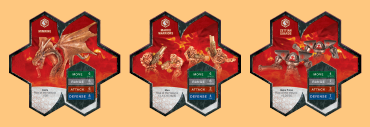 EXAMPLE 1: Your Army Cards
EXAMPLE 1: Your Army Cards
You’ve chosen the Army with Mimring (Hero) and two Squads (four Marro Warriors and
two Zettian Guards). You’ve taken your three Army Cards and placed them in front of
you, and you’ve placed your Army (all seven figures) on their starting positions on
the battlefield.
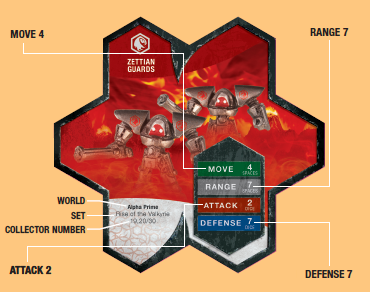 EXAMPLE 2: Army Card Information
EXAMPLE 2: Army Card Information
MOVE 4 - Heavy armor makes the Zettian Guards slower than many other figures. You can move
each one up to 4 spaces.
RANGE 7 - Laser-powered weaponry gives the Zettian Guards a fairly long range; each one can
attack from up to 7 spaces away.
ATTACK 2 - Lack of agility can affect the Zettian Guards’ aim. For each attacking Zettian Guard,
you roll 2 attack dice.
DEFENSE 7 - The Zettian Guards are well protected by their armor. Each time one is attacked,
you get to roll 7 defense dice.
World - Before being summoned by Utgar, the Zettian Guards were originally from Alpha Prime
(the character's home world).
Set and Collector Number - This tells you which set (or Story Arc) they came in, and their number within that set.
2. PLACE THE COMBAT DICE
Position the combat dice near the battlefield and within reach of both players. The
combat dice are used as attack dice (rolling for skulls) and also as defense dice
(rolling for shields).
Unless otherwise directed by your chosen Game Scenario, you don’t need any other game parts for the Basic Game. Just place them aside, out of play.
The Battle Begins!
Each player rolls 6 combat dice. The player who rolls the most skulls takes the first turn. (Re-roll if there’s a tie.) Players then alternate turns until the game is over.
ON YOUR TURN
Usually, you’ll do three actions on your turn, in this order:
Action 1. Choose an Army Card
Action 2. Move Figure(s) shown on your Army Card
Action 3. Attack with Figure(s) shown on your Army Card
All three of these actions are explained in detail in the following sections.
Action 1. Choose an Army Card
First, choose one of your Army Cards to use on your turn. You can't choose a card
if all of its figures have been destroyed.
Action 2. Move Figure(s) shown on your Army Card
Now you may move any or all figures shown on your chosen Army Card. Follow these rules
for moving each figure:
- Check the Move Value: You can move a figure in any direction, a number of spaces up to the Move Value on its Army Card. For example, with a Move Value of 4, the Zettian Guards can each move 0, 1, 2, 3 or 4 spaces. Uneven terrain and water might limit their movement, as you’ll soon see. Example 3 shows basic movement.
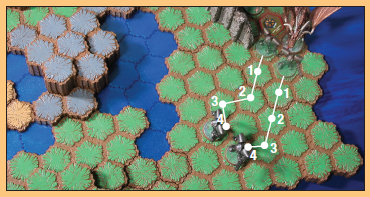 EXAMPLE 3: Basic Movement
EXAMPLE 3: Basic Movement
On this turn, you choose to move each Zettian Guard its full 4 spaces.
- Order of movement for Squads: You may move a Squad's figures in any order you choose, one at a time.
- Passing and landing on other figures: You can move through a space with a figure you control on it; but you can’t move through a space with an opponent’s figure on it. You can never end a move on a space with any other figure.
- Moving up and down: Each layer of same-height tiles is called a level. Your figure’s level is the same as the level of tile it is currently standing on. When you move to a higher level, count the side of each tile you ascend to determine how much extra movement it takes to reach the new higher level. When you move to any lower level, you don’t need to count extra movement on the way down. Examples 4 and 5 show how to move up and down.
 EXAMPLE 4: Moving up
EXAMPLE 4: Moving up
You must count 4 spaces for your Zettian Guard to move up onto this ledge; one for
each level, and one for moving onto the space.
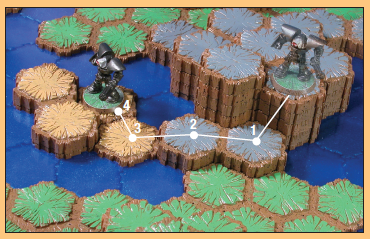 EXAMPLE 5: Moving down
EXAMPLE 5: Moving down
To get down from this ledge, your Zettian Guard counts only 1 space for this move.
- Moving onto water: When you move onto a water space from any other space (even from another water space), you must end your move there. See Example 6.
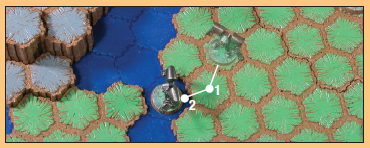 EXAMPLE 6: Moving onto water
EXAMPLE 6: Moving onto water
When moving onto the water space, your Zettian Guard must stop after moving only 2
spaces.
- Moving from water onto land: For water spaces that are lower than any adjacent land spaces, the “moving up” rule applies. When moving from water to land, count the side of each land space as you move up. See Example 7.
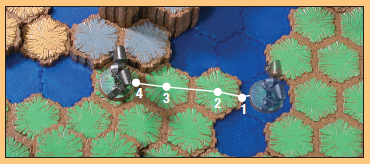 EXAMPLE 7: Moving out of water
EXAMPLE 7: Moving out of water
When moving from the water space to the adjacent land space, your Zettian Guard must
count 2 spaces.
- Moving double-space figures: Some figures, such as Grimnak or Mimring, take up two spaces. When moving a double-space figure, decide which half to lead with. Then move the figure so that the other half enters the same spaces that the leading half just left.
- You must always end a double-spaced figure’s move on two spaces of the same level.
- A double-space figure does not have to stop when it moves over one water space between two land spaces, but it does have to stop if it moves onto two adjacent same-level water spaces. Note: A double-space figure with its leading half on a water space, cannot move to another water space on a different level, because it cannot end its movement on uneven terrain. Example 8 shows how to move a double-space figure.
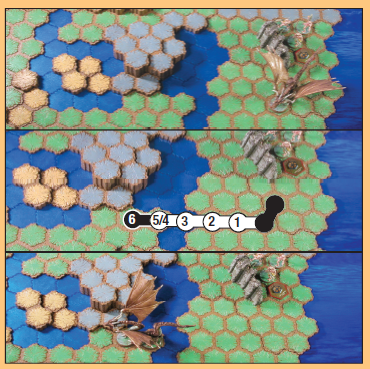 EXAMPLE 8: Moving double-space figures
EXAMPLE 8: Moving double-space figures
From his starting spaces (top picture), Mimring moves 6 spaces headfirst (one half), with his back section (the other half) following along the same spaces (middle picture). Notice that Mimring counts the
side of the land space when moving up from the water space. His move ends across the
water on two spaces of the same level (bottom picture).
Other movement rules: There are a few other movement rules mentioned in the Master Game Guide, that are assumed applicable in a Basic Game, but were never mentioned in the Basic Game Guide. These rules are:
- Flipping a double-space figure here
- Overhangs
- Keep the base on the space
- Tight quarters
- Adjusting figures here (mentioned in Attack rules section)
Action 3: Attack with Figure(s) shown on your Army Card
Now it’s time for your Hero or Squad to attack any figures in your opponent’s Army
that they can.
Who can attack? Any figures shown on your chosen Army Card within Range of an opponent’s figure, and have a clear Line of Sight, can attack. If no figure on your Army Card meets these two conditions, you can’t attack and your turn is over.
To see if a figure can attack, check the figure's Range and Line of Sight as explained below:
- Range: A targeted figure must be within the Attacking figure’s Range. For example, with
a Range of 7, a Zettian Guard can attack any enemy within 7 spaces from it (as long
as it can see it).
A figure with a Range Value of 1 can attack a figure only from an adjacent space.
- A double-space figure, such as Grimnak or Mimring, can attack from either space it occupies.
- When checking a figure’s Range, don’t count extra spaces for higher levels. (However, being on a higher level is an advantage during an attack; see below.) If the distance between your figure and the targeted figure includes an area with no spaces (for example, near the edge of the battlefield), then you must count the spaces along the edge of the battlefield to check the Range.
- Line of Sight: To attack a targeted figure, your figure must be able to “see” it from its location. For example, if the targeted figure is behind a stack of tiles, so that the attacker can’t see any part of it, then no attack is possible.
- Unlike Range, Line of Sight is an imaginary straight line that has nothing to do with the spaces on the battlefield. The best way to tell if your Attacker has a clear Line of Sight is to get behind its head and look at the targeted figure. If you can see any part of it from the Attacker’s head, you have a clear Line of Sight. Note: It doesn’t matter if the Line of Sight goes off the edge of the battlefield, with no spaces below it.
- When targeting a double-space figure, if one half is within range and the other half is not, and you can only see the half that is not in range, you may still attack the figure.
- Example 9 shows how to determine if a targeted figure is within an attacker’s Range and Line of Sight.
 EXAMPLE 9: Range and Line of Sight
EXAMPLE 9: Range and Line of Sight
You want your Zettian Guard to attack an Airborne Elite figure.
1. First, you count the spaces from the Zettian Guard to the Airborne Elite: the Airborne
Elite is 7 spaces away, so the figure is just within the Zettian Guard’s Range.
2. Then, you check for a clear Line of Sight. Your Zettian Guard can “see” the Airborne
Elite figure, so it can attack.
ATTACKING
If you’re attacking with a Squad, each figure shown on your chosen Army Card can attack,
one at a time, in any order you choose. Each figure can attack only once per turn.
Different figures may attack the same opposing figure or different opposing figures.
For each Attacker, follow the steps below:
- Announce which one of your figures is the Attacker and which figure it is targeting. The target figure becomes the Defender.
- Check the Attack Value on your attacker’s Army Card, and then roll that number of attack dice. After you roll, your opponent rolls a number of defense dice equal to the Defense Value on the defender’s Army Card.
Height Advantage: If the base of one figure is on a higher level than the base of the other figure (no matter what their actual size), the higher figure rolls one extra die.
- For every skull you roll (as attacker) your opponent (defender) must roll a shield to block it. IMPORTANT: For attack rolls, the attacker counts only skulls. For defense rolls, the defender counts only shields.
- If you roll more skulls than the defender rolls shields, your attack is successful and the defending figure is destroyed. The player who controls it removes it from the battlefield.
- If the defender rolls an equal number or more shields than you rolled skulls, then your attack is unsuccessful. The attacking and defending figures stay where they are, and that attack is over.
After you attack with every figure that can attack, your turn is over.
Example 10 shows an attack and its outcome.
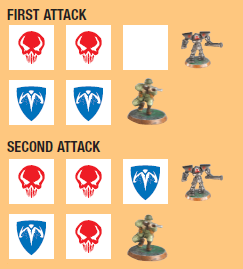 EXAMPLE 10: The Zettian Guards Attack!
EXAMPLE 10: The Zettian Guards Attack!
Each Zettian Guard is within Range of an enemy Airborne Elite figure, and has a clear
Line of Sight. You choose one Zettian Guard to launch the first attack.
FIRST ATTACK
Zettian Guards have an Attack Value of 2, which means you roll 2 attack dice. But
this Zettian Guard has a height advantage over the defender, so you roll 1 extra attack
die (a total of 3 dice): 2 skulls appear for the attacker.
The defender has a Defense Value of 2. Your opponent rolls 2 defense dice: 2 shields appear for the defender.
The defender blocks the attack. Both figures stay where they are. Now your other Zettian
Guard can attack.
SECOND ATTACK
You decide to attack the same defender. This attacking Zettian Guard also has a height
advantage, so again you roll 3 attack dice: 2 skulls appear for the attacker.
For the defender, your opponent rolls 2 defense dice: 1 shield appears for the defender.
You win the attack! Your opponent removes the destroyed Airborne Elite figure from
the battlefield. You have no attacks left to make, so your turn is over.
Ending the Battle
Keep playing until one player achieves the victory objective of the chosen game scenario. That player wins the battle!
Create Your Own Battlefield
With experience, you may want to build your own battlefields and create your own game
scenarios, armies, and victory conditions. Good luck, and may the best Valkyrie General
win!
Road to the Forgotten Forest
Roads
Moving on Road Spaces: When moving your figures on road spaces, count each space as a normal space. However, if your figure's entire move consists of road spaces, including the starting space (or both starting spaces for double-space figures), you may add an additional 3 spaces to your figure's move. The additional spaces must also be on road spaces. See Example 11.
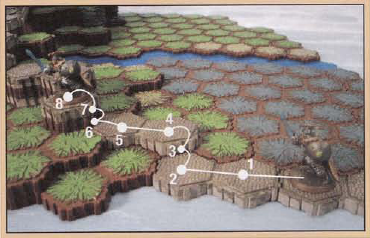 EXAMPLE 11: Moving on Road Spaces
EXAMPLE 11: Moving on Road Spaces
Finn's move is 5. Finn's entire move is on road spaces, so he can move 8 total spaces.
Stone Walls
Moving over Stone Walls:
Figures may move over stone walls. When moving over a stone wall, count the height
of the stone wall as spaces. The height of the inside wall (the side connected to
the tile) is 2. The height of the outside wall (the side not connect to a tile) is
3. See Examples 12, 13 and 14.
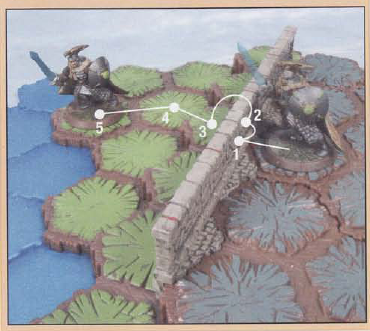 EXAMPLE 12: Moving over an inside wall
EXAMPLE 12: Moving over an inside wall
Finn has a move of 5. The inside wall costs 2 movement spaces to move over because
it has a height of 2.
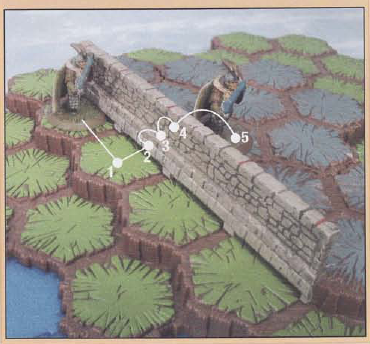 EXAMPLE 13: Moving over an outside wall
EXAMPLE 13: Moving over an outside wall
The outside wall costs 3 movement spaces to move over because it has a height of 3.
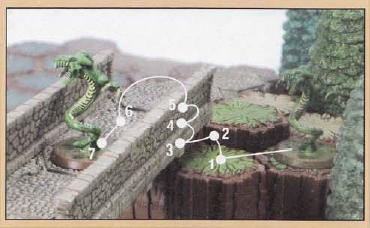 EXAMPLE 14: Moving over an outside wall
EXAMPLE 14: Moving over an outside wall
When a figure moves over an elevated outside wall, be sure to count the height of
the wall and nearby support tiles.
A figure cannot move over a stone wall if it cannot move enough spaces to get to an empty space on the other side.
Line of Sight Marks:
Line of Sight Marks are the red markings on the tops of the stone walls used only
for range attacks. They are used for Line of Sight only when attacking from the inside
of the stone wall. A figure next to a Line of Sight Mark may use this mark instead
of his or her head. It is the equivalent of leaning over the wall to target an opponent. To use a Line
of Sight Mark, choose a Line of Sight Mark that is next to the space your figure is
on. Then target your opponent by lining up the Line of Sight Mark at the outside edge
of the wall to your target. If there is a clear line of sight, you may use a range
attack. See Example 15.
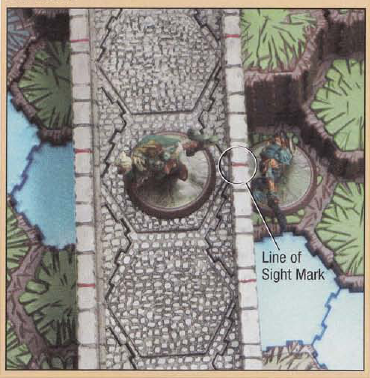 EXAMPLE 15: Using a Line of Sight Mark
EXAMPLE 15: Using a Line of Sight Mark
Syvarris using his head cannot see the Blade Grut. However, when Syvarris uses the Line of Sight Mark on
the Stone Wall, he can see the Blade Grut and therefore can attack.
Evergreen Trees (or Snowy Evergreen Trees)
Moving Around Evergreen Trees:
Figures are not allowed to move through any spaces that are occupied by trees. Figures
cannot move through any of the 4 spaces occupied by evergreen tree 15.
Line of Sight:
All evergreen trees block Line of Sight. Long range attacks can only be used when
a clear Line of Sight is available between evergreen trees. See Example 16 and 17.
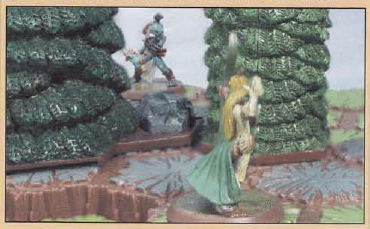 EXAMPLE 16: Looking between the trees
EXAMPLE 16: Looking between the trees
Syvarris can easily see the Blade Grut between the trees.
 EXAMPLE 17: Looking between the trees
EXAMPLE 17: Looking between the trees
There is a small area but Syvarris can see the Blade Grut between the trees.
Volcarren Wasteland (Lava Fields)
Molten Lava
Figures may not move onto molten lava spaces.
Lava Fields
There are no special rules for moving onto or through lava field spaces.
Thaelenk Tundra (Snow Fields)
Ice
Figures may move on Ice Tiles by counting each hex as 1 space. Ice Tiles do not add height. Do not count Ice Tiles when moving up or down.
Snow
There are no special rules for moving onto or through Snow Tiles.
Glacier Mountains
Figures may not land on or move through Glacier Mountains. If Glacier Bases are used as Ice Tiles follow the above rules for Ice Tiles.
Fortress of the Archkyrie
Fortress Walls
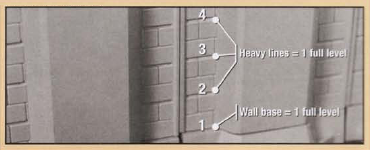 EXAMPLE 18: Counting Levels on Fortress Walls
EXAMPLE 18: Counting Levels on Fortress Walls
The Fortress Walls are marked with heavy lines to help count levels. Each heavy line
equals 1 full level.
Wall Walks
Using Wall Walk Tiles as Road Tiles: When Wall Walks are not supported by Fortress Walls, you can link and stack them the same way you link and stack other terrain tiles such as grass, sand, and rock tiles. The Wall Walks then become Road Tiles in your battlefield.
Moving on Wall Walk Tiles or Road Tiles: Wall Walk Tiles or Road Tiles create spaces that may allow your figures to travel more quickly than normal. Figures may move on and occupy all Wall Walk or Road spaces similar to other normal terrain spaces such as rock, grass, or sand. When moving your figures on Wall Walk or Road spaces, count each space as a normal space. However, if your figure's entire move, including the starting space (or both starting spaces for double-space figures), consists of Wall Walk spaces, Road spaces, or a combination of both, your figure receives a bonus and you may add 3 spaces to your figure's move. The 3 additional spaces must also be on Wall Walk and/or Road spaces. Figures cannot use ladders with the bonus. Example 19 shows a figure walking on a Wall Walk.
 EXAMPLE 19: Moving on Wall Walk Spaces
EXAMPLE 19: Moving on Wall Walk Spaces
The Tarn Viking Warrior's Movement is 4. His entire move is on Wall Walk Spaces, so
he can move 7 (4+3) total spaces.
When a figure moves from one Wall Walk to a higher level, the figure must add the difference in height to the movement, similar to the "Moving Up" rule here. When moving down to a lower Wall Walk space, you do not need to count the difference in levels.
Battlements
Moving over Battlements: Figures may move over Battlements. Count the lowest part of a Battlement as spaces in addition to any difference in levels that may need to be counted during the figure's movement. The height from the inside of a Battlement (the side connected to a tile) is 2. The height from the outside of a Battlement (the side not connected to a tile) is 3. See Examples 20 and 21.
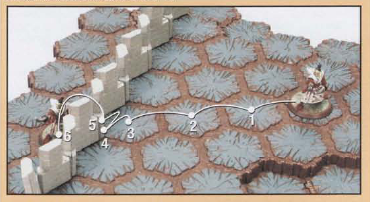 EXAMPLE 20: Moving over a Battlement from inside
EXAMPLE 20: Moving over a Battlement from inside
The Izumi Samurai has a move of 6. The inside wall costs 2 movement spaces to move
over because it has a height of 2.
 EXAMPLE 21: Moving over a Battlement from outside
EXAMPLE 21: Moving over a Battlement from outside
The Izumi Samurai has a move of 6. The outside wall costs 3 movement spaces to move
over because it has a height of 3.
Line of Sight: Battlement Points may be used for getting Line of Sight. Battlement Points, on the corners of the Battlement, are used only for range attacks. They are used for Line of Sight only when attacking from the inside of the Battlement. A figure next to a Battlement Point may use this point instead of his or her head. It is the equivalent of leaning over the Battlement to target an opponent.
To use the Battlement Point, choose a Battlement Point that is next to the space your figure is on. Then target your opponent by lining up the Battlement Point at the outside edge of the Battlement to your target. If there is a clear Line of Sight, you may use a range attack. See Example 22.
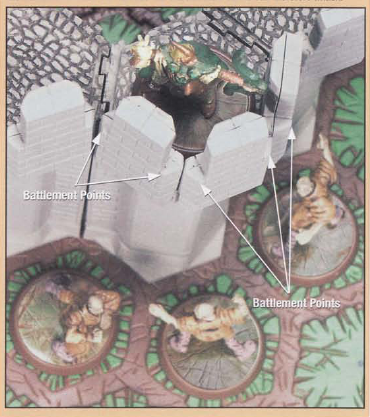 EXAMPLE 22: Battlement Points
EXAMPLE 22: Battlement Points
Using his head, Syvarris cannot see the Shaolin Monks. When Syvarris uses the Battlement Points,
he can see the Monks, and can therefore attack.
The Doorway
The Doorway allows figures to enter and exit a Fortress. Attached to the Doorway is a moveable Door that may be opened and closed. Figures cannot see or target other figures through the Doorway when the Door is closed. Only figures are allowed to occupy the 4 Doorway spaces. See Example 23.
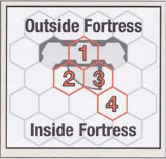 EXAMPLE 23: The 4 Doorway Spaces
EXAMPLE 23: The 4 Doorway Spaces
The Fortress Door: The Door may be opened and closed. In the Basic Game, the Door cannot be destroyed or attacked. The Door Card is not used. Unless specified differently at the beginning of a scenario, the Door starts every game in the closed position.
Rules for Opening or Closing the Door:
- A player with a figure on Doorway Space #4 may open or close the Door whenever needed during that player's turn. If the figure moves from this space or is destroyed, and the space remains unoccupied, the Door cannot be opened or closed.
- When the door is closed, it must be completely closed to occupy the space in the Doorway (Space #1). When closed, it is considered barred from the inside and may not be opened from the outside by any enemy figures.
- When the Door is open, it must be opened completely to occupy Space #3 as shown in Example 24. Only those figures that can fit on and move through Space #1 are allowed to pass through the Doorway.
- When opening or closing the Door, all spaces #1, #2, and #3 must be unoccupied. If there is a figure on one of these spaces, the Door may not be opened or closed.
 EXAMPLE 24: Opening the Door
EXAMPLE 24: Opening the Door
A Tarn Viking is on Doorway Space #4 and therefore has control of the Fortress Door.
He has opened it to allow the Knight to enter.
Ladders
A ladder may consist of 1 or more Single-Rung Ladder Pieces. Ladders may be used only by single-space figures, to allow them to move onto spaces on walls and terrain. If a ladder is unoccupied, double-space figures can bypass the ladder using normal rules for moving up, counting the levels behind the ladder. Single-space figures cannot bypass Ladders while moving up the side of the terrain where it has been placed.
Movement on Ladders: Figures may move onto a Ladder by moving onto a Rung Space, counting the move to this rung as if it were a hex-shaped tile space. To end a figure's move on a Ladder, slide its base into a rung.
Treat each figure on a rung as if it were on a hex-shaped tile space. All rules for normal movement on hex-shaped tile spaces apply to figures on Ladders except the following:
- When moving up or down, each rung counts as 1 space; do not count levels.
- Figures are not allowed to skip rungs.
Only one ladder may be built on a hex-shaped tile space such as grass, rock, sand, etc. This space is called the Landing Space. Move on and off Ladders as shown in Examples 25-31.
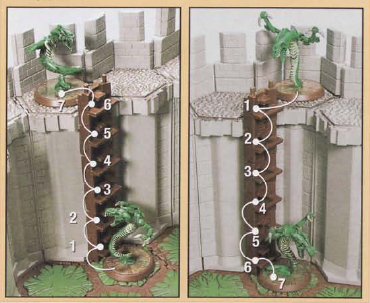 EXAMPLE 25: Using the Landing Space
EXAMPLE 25: Using the Landing Space
Moving onto a Ladder from a Landing Space (left image). Moving off of a Ladder onto
a Landing Space (right image).
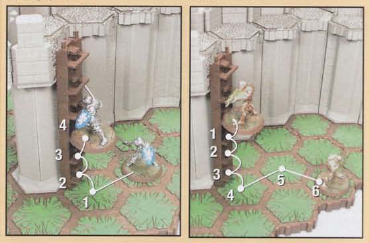 EXAMPLE 26: Counting the Landing Space
EXAMPLE 26: Counting the Landing Space
Moving onto a Ladder and counting the Landing Space (left image). Moving off of a
Ladder and counting the Landing Space (right image).
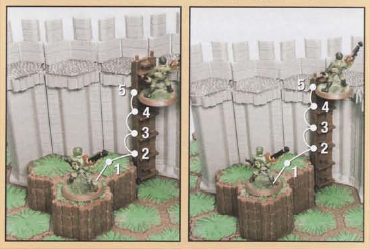 EXAMPLE 27: Moving onto a Ladder from a hex tile space
EXAMPLE 27: Moving onto a Ladder from a hex tile space
Moving onto a Ladder Rung from a same-level hex tile space (left image). Moving onto
a Ladder Rung from a different-level hex tile space (right image).
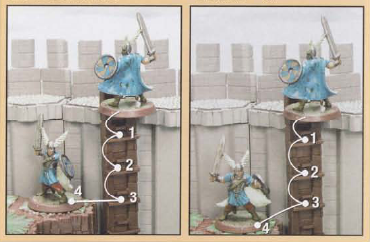 EXAMPLE 28: Moving off of a Ladder and onto a hex tile space
EXAMPLE 28: Moving off of a Ladder and onto a hex tile space
Moving off of a Ladder onto a same-level hex tile space (left image). Moving off of
a Ladder onto a different-level hex tile space (right image).
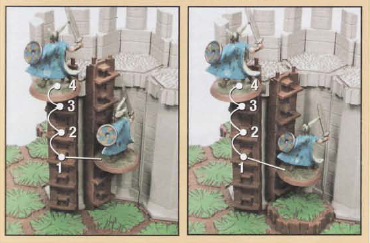 EXAMPLE 29: Moving from one Ladder to another Ladder
EXAMPLE 29: Moving from one Ladder to another Ladder
Moving from one Ladder to a same-level Ladder (left image). Moving from one Ladder
to a different-level Ladder (right image).
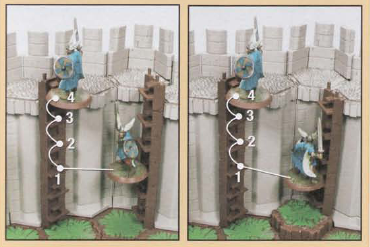 EXAMPLE 30: Moving from one Ladder to another Ladder
EXAMPLE 30: Moving from one Ladder to another Ladder
Moving from one Ladder to a same-level Ladder (left image). Moving from one Ladder
to a different-level Ladder (right image).
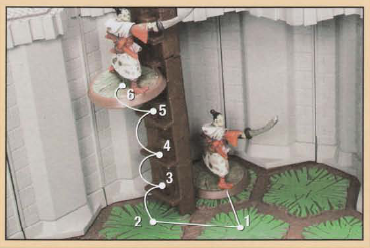 EXAMPLE 31: Moving around Ladders
EXAMPLE 31: Moving around Ladders
This Izumi Samurai must move around the Ladder to use it or to occupy the Landing
Space. Figures may not move through Ladders.
Targeting Bases: The bases of all figures on Ladders can be targeted for attack by all other figures. See Example 32.
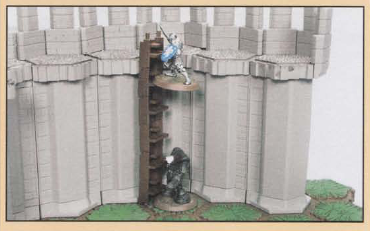 EXAMPLE 32: Targeting a figure's base
EXAMPLE 32: Targeting a figure's base
The Knight of Weston is on the Ladder; therefore, the Zettian Guard can target the
knight's base.
Line of Sight using Bases: Figures on Ladders may use the entire edge of their base as an alternate to using their head when checking for Line of Sight. See Example 33.
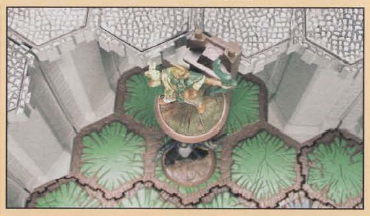 EXAMPLE 33: Using the edge of a figure's base for Line of Sight
EXAMPLE 33: Using the edge of a figure's base for Line of Sight
Syvarris can target Agent Carr using the edge of his base.
Height Advantage: Figures on a Ladder may receive Height Advantage for attack and defense as explained in the Basic Game Guide. See Examples 34 and 35.
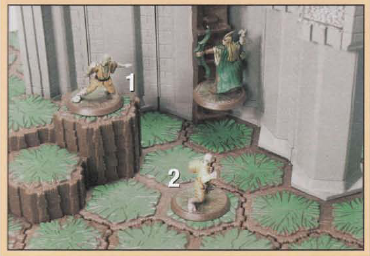 EXAMPLE 34: Height Advantage for an attack from a Ladder
EXAMPLE 34: Height Advantage for an attack from a Ladder
Syvarris has a Height Advantage on Shaolin Monk 2 but not on Shaolin Monk 1, so he
adds on extra attack die when attacking Shaolin Monk 2.
 EXAMPLE 35: Height Advantage for defense on a Ladder
EXAMPLE 35: Height Advantage for defense on a Ladder
The Shaolin Monk has a Height Advantage on Zettian Guard 2 but not Zettian Guard 1,
so he adds one extra defense die only when defending against Zettian Guard 2.
The Flag
The Flag does not have any special powers unless specified in a scenario.
The Conflict Begins
Warehouse Ruin
The Breakable Wall Section: In the Basic Game, the Breakable Wall Section cannot be destroyed or attacked. The Breakable Wall Card is not used. Unless specified differently at the beginning of a scenario, the Breakable Wall Section starts every game in the Warehouse Ruin.
Secondary Story Spaces: These two spaces are not used in the Basic Game. Figures are not allowed to move onto these two spaces. See Example 36.
 EXAMPLE 36: Secondary Story Spaces
EXAMPLE 36: Secondary Story Spaces
Figures are not allowed to move onto the spaces marked with an X.
Swarm of the Marro (Swamps)
Swamp Water
Moving onto swamp water: Unlike moving onto water, when you move onto a swamp water space from any other space, you may continue moving if you have moves left.
Moving from swamp water to land: For swamp water spaces that are lower than their adjacent land spaces, the “moving up” rule applies. When moving from swamp water to land, count the side of each land space as you move.
Marro Hive
Marro Hive Rules: If the Marro Hive was placed on the battlefield as directed by a Basic scenario, if it is destroyed remove the Hive and leave the 6-hex swamp water tile base on the battlefield.
Ticalla and Laur Jungles
Jungle Pieces (Palm Trees, Jungle Trees and Underbrush)
Moving through a Jungle Piece: Figures are not allowed to occupy or move through Jungle Pieces.
You may remove a Palm or Jungle Tree canopy to access hard-to-reach areas of the battlefield, but you must reattach it afterwards. If a figure cannot fit on a space under a canopy, you cannot remove the canopy to allow the figure to move onto that space.
When moving your figure adjacent to a Jungle Piece, you are allowed to move any of the lower plants of the Jungle Piece that hang over the space that the figure will occupy. A figure may not be placed on any space adjacent to a Jungle Piece if the figure being placed does not fit fully on the space.
Line of Sight: Jungle Pieces may block Line of Sight. Range attacks can be used only when a clear Line of Sight is available between or through Jungle Pieces. See Examples 37 and 38.
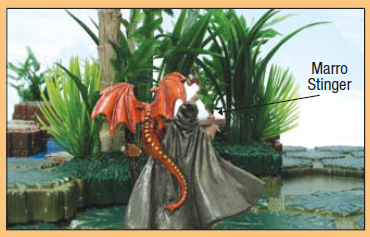 EXAMPLE 37: Seeing Through Jungle Pieces
EXAMPLE 37: Seeing Through Jungle Pieces
Sonlen can see the Marro Stinger through the Jungle Pieces.
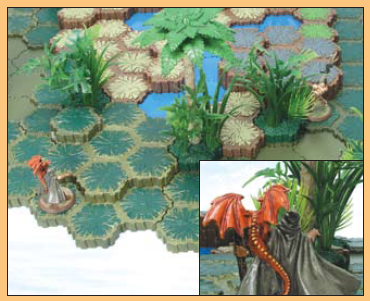 EXAMPLE 38: Not Seeing Through Jungle Pieces
EXAMPLE 38: Not Seeing Through Jungle Pieces
Sonlen cannot see the Marro Stinger through the multiple Jungle Pieces.
Battle for the Underdark
Shadows
Moving onto shadow spaces: Unlike moving onto water, when you move onto a shadow space from any other space, you may continue moving if you have moves left.
Moving from shadow spaces to land: For shadow spaces that are lower than their adjacent land spaces, the “moving up” rule applies. When moving from shadow spaces to land, count the side of each land space as you move.
Battle for the Wellspring
Wellspring Water
Wellspring water is a type of water, and follows all normal water rules.